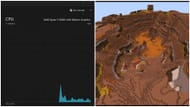Even though Minecraft is a dated, pixelated block game, it can still take a toll on any device if played for a long time. Since the game has a near-endless map, it keeps loading and unloading map chunks and everything they contain when the player is traveling from one point to another. Overall, it is a bit tricky to pinpoint which part of the device is bottlenecking and causing the lag.
Hence, here are some of the possible reasons why Minecraft could lag on a device.
A few reasons why Minecraft might lag on a device
7) Complex redstone contraptions

Chart New Territories with the ultimate Minecraft Seed Generator!
Players might not realize it, but redstone contraptions in Minecraft do put some extra pressure on the device. Massive redstone machines need a lot of computing power to run in the game since blocks and items are constantly interacting with each other.
Hence, the sandbox title keeps demanding more from the device, which can cause a lot of lag. The amount of lag depends on the complexity and scale of the contraption.
6) Shaders on high settings

Shaders make the game look extremely beautiful by changing a lot of aspects of the graphics. Almost every shader pack comes with a settings panel from which the intensity of the graphics can be adjusted.
If the graphics are set too high, there are high chances that the device will start lagging. The best way to tackle this is by lowering the settings and finding a sweet spot.
5) GPU bottleneck

Though the sandbox game draws mainly from the CPU, there are instances when it might put some pressure on the GPU. One of the primary moments when the GPU starts running more is when players use shader packs.
The aforementioned pointer is when a shader pack's settings are too high. There can be low-end GPUs that might not even be able to handle any shader packs. In this case, they can bottleneck and cause lag.
4) High rendering distance

Render distance is a setting to increase or decrease the amount of chunks loading around the player at any given time. The higher the render distance, the more chunks are loaded and allow players to see far-off places. However, the game needs more computing power to process more blocks and terrain generations, which can also contribute to lag.
3) Background processes

Of course, this is a universal issue when users play any game on their device. They must always make sure that no other background process or download is running while they play the block game. Every process takes up space in the RAM, and since the game requires quite a lot of it, this situation can lead to lag.
2) Low RAM Allocation (Java Edition only)

By default, the game launcher allocates 2 GB of RAM for a Java Edition version. However, this can be too low for those who want more out of their game. Hence, the low RAM allocation can also cause lags and FPS drops. This can be easily resolved by going into the installation settings in the launcher and increasing the RAM for any version.
1) CPU Bottleneck

The CPU is one of the most important parts of a device since it is responsible for all the computing that needs to be done in order to run anything. The sandbox game mainly uses CPUs to generate and compute every single thing. Hence, if players are experiencing lag despite resolving all the above mentioned issues, chances are that they have a CPU bottleneck.
Uncover new worlds with our Minecraft Seed Generator!

